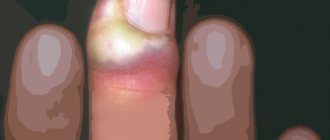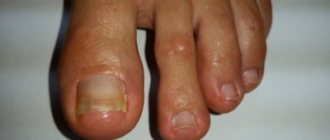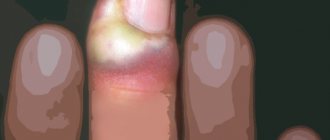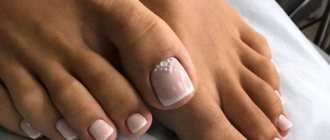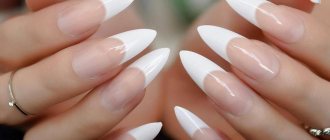Ingrown toenail treatment with staples without surgery
Many people experience the phenomenon of onychocryptosis (ingrowth of the side of the nail into the skin).
This is a rather painful illness, which is accompanied by a lot of unpleasant sensations. Most often, this phenomenon can be found on the toes. Ingrown toenails are treated in various ways. But most people strive to find a way to cure an ingrown toenail without surgery in order to reduce rehabilitation time. According to statistics, this pathology occurs more often in active young people, and men suffer from this pathology much more often.
Treatment of an ingrown toenail without surgery
Even one nail can become a serious problem. It not only hurts, but over time it can fester and become inflamed. This issue cannot be run. Many people try to cure the disease without surgery, but there are cases when surgical intervention is necessary, for example, when an infection occurs. However, surgery can be avoided if you immediately contact a good specialist.
Bracket ZTO
Treatment of an ingrown toenail, including on the big toe, is carried out with staples, special plates and other methods.
Their essence is that a staple is inserted between the nail and the skin, directing the growth of the nail. The installation procedure can be painful, so it is carried out with painkillers. This treatment is very effective and, importantly, non-invasive. The surface is first disinfected and the nail is softened. The duration of wearing such a brace depends on the stage of the disease and other factors.
The most popular treatment methods at the moment are:
- Fraser staples
. Convenient staples in the form of hooks that cling to the side of the nail and are pulled tight. They are effective and almost invisible. You can complement them with rhinestones and other decorations. - Combiped staples.
This brace will help get rid of onychocryptosis if the nail is ingrown on only one side. The hook clings to the edge of the nail and the other end to a special platform. - Podofix plates.
Such a plate is made of an elastic material, and there is a wire inside. It is attached to the nail and tightened. This is one of the most effective and convenient treatment methods, since such plates do not interfere with wearing shoes. - B/S plates.
They differ in shape, so the doctor will be able to choose an option for each case. The plates are made of plastic, thin, attach well to the nail, and lift its edge. They are almost impossible to notice on the leg. - ZTO staples.
Their peculiarity is that they have 3 components: two hooks and a loop. The hooks are attached to the edges of the nail, and the loop tightens them. This allows you to regulate nail growth.
People often wonder how to cure an ingrown toenail in a child without surgery. To do this, you should not delay your visit to the podiatrist. The sooner treatment begins, the better. The doctor will carefully examine the nail and select the optimal treatment regimen.
It is possible to treat an ingrown toenail with folk remedies, but it is better not to get carried away with self-medication, since they do not always help solve the problem, and can even worsen it. You can miss time and develop a disease.
A universal method for correcting ingrown toenails using a flexible steel plate coated with gold “Goldspang”
Fraser bracket
Goldspang plate
Podofix plate
Causes of ingrown toenails
Among the reasons for the appearance of an ingrown toenail, experts indicate the following:
- Orthopedic disorders, flat feet, crossed toes, foot deformities;
- Hereditary prerequisites in the form of an excess amount of soft tissue of the subungual pad, which causes excessive pressure on the nail plate;
- Systematic lifting of weights;
- Excess body weight;
- Frostbite;
- Damage to the nail plate by a fungal infection or psoriasis, which will contribute to its thickening and deformation, changing the direction of growth;
- Systematic wearing of ill-fitting shoes, of the wrong size, with narrow toes, high heels;
- Incorrectly performed pedicure or improper trimming of the nail plate.
Symptoms of an ingrown toenail
An ingrown toenail can be found in both men and women. The pathology also occurs in children.
The first signs of the disease are painful sensations that are detected only when walking in problematic shoes. Externally, the skin of the finger looks swollen, reddened, and an ulcer is noted at the site of the ingrown nail. Depending on the stage of the process, purulent discharge may occur.
Stages
Symptoms develop gradually, which has given rise to several stages of the disease.
- In the first stage, signs of inflammation are absent or minimally expressed; painful sensations that appear when walking in uncomfortable shoes are characteristic. If the shoes are removed, symptoms quickly regress;
- The second stage of the process is characterized by more pronounced clinical manifestations. Pain may also be present at rest. There are signs of inflammation: the finger near the nail looks reddened and swollen;
- The third stage is characterized by purulent discharge at the edge of the nail plate. The nature of the pain also changes. It becomes pulsating, constant, and intensifies at night. Palpation of the lesion is accompanied by a sharp increase in pain. The finger becomes purple or bluish. Often the patient’s general condition is also impaired. He complains of malaise, increased body temperature;
- The fourth stage is characterized by periodically occurring purulent process and the formation of granulation tissue. The presence of this sign indicates a chronic course of the disease. In the absence of correct treatment, the pathological process also affects bone tissue.
Diagnostics
Diagnosis is based on
- The patient complains of pain localized within the finger;
- Studying the anamnesis, when it turns out that the situation worsens when wearing uncomfortable shoes;
- Studying the anamnesis, when it turns out that the situation worsens when wearing uncomfortable shoes;
- X-ray examination, which, in severe cases of the process, will confirm damage to bone structures.
If you have an ingrown toenail, you may also need laboratory diagnostics to confirm or rule out a fungal infection. This will allow you to prescribe more effective treatment that takes into account the concomitant factor.
Why do nails grow ingrown?
The most common cause of the disease is improper pedicure technique. The nail grows into the skin if you use scissors with rounded edges and cut off its corners.
The second most common cause is a fungus (onychomycosis). It leads to delamination of the plate, so it becomes brittle and can bend and “cut” into the roller.
Other causes of ingrowth may be:
- pressing shoes, narrowed toes of shoes, boots;
- hereditary predisposition;
- blow, bruised finger.
These are key factors in the disease, but not the only ones. Inflammation of an ingrown toenail can also develop with flat feet, diabetes, and obesity.
Cost of treatment. Operation price
| Service | Cost, rub) |
| Initial appointment. Consultation | 1500 |
| Removing an ingrown toenail is simple | 2500 |
| Removal of ingrown toenails using the radio wave method | 3500 |
| Removal of an ingrown nail using the radio wave method with plastic surgery of the periungual fold according to Schmieden | 4500 |
Symptoms and stages of the disease
An ingrown toenail or hand nail injures the nail fold. As the disease progresses, its manifestations intensify. There are 3 stages:
- first. A person complains of pain when pressing on a finger, slight swelling appears;
- second. The skin around the nail plate becomes red, the person experiences pain when walking, it is difficult for him to wear shoes, and sometimes pus appears;
- third. The soft tissue grows, painful tumor growths appear, and there is more purulent discharge. The person complains of severe pain, cannot walk, and limps.
An ingrown fingernail or toenail is a reason to seek advice from a specialist. Unfortunately, many often ignore this recommendation, use the advice of friends and self-medicate. With onychocryptosis, this approach can lead to a worsening of the situation and the development of complications.
Complications
Complications of onychocryptosis occur with prolonged course and further development of the inflammatory process. Such complications include:
- abscess of the toe - swelling, redness of the entire nail phalanx and the formation of a cavity with purulent contents;
- gangrene of the toe - irreversible necrosis of the soft tissues of the foot, accompanied by blackening of the skin;
- osteomyelitis of the nail phalanx of the finger - an infectious inflammatory process that affects the entire bone of the phalanx;
- lymphangitis and/or lymphadenitis is inflammation of the lymphatic vessels and lymph nodes, developing as a result of the spread of the inflammatory process from the source of infection.
Ingrown toenail - what to do?
If the nail begins to rest on the nail fold, experts advise not to get your foot wet and not to wear synthetic socks or tights. Also contraindicated:
- apply varnish;
- lubricate the ingrown nail area with lemon juice, honey, and use other folk remedies;
- trim the ingrown plate yourself, pry it off with manicure accessories.
When primary signs of the disease appear, it is worth replacing shoes with comfortable, spacious ones that match the size of the foot. If symptoms of the second stage of the disease have already appeared, you should immediately consult a doctor. A podiatrist will tell you how to properly treat an ingrown toenail. He will also introduce you to preventive measures for onychocryptosis and other possible diseases.
Help yourself
Do not think that the issue will be resolved on its own. With inactivity, the indicators will increase, and the pain will bother you even in the absence of movement. What to do if a nail grows on your foot?
The initial level involves careful care of the affected area. Warm baths, several times a day, with the addition of salt, soap, and antibacterial agents will be beneficial.
After this, try to slip a gauze flagellum soaked in chlorhexidine and myrogen under the ingrown part of the nail. They change it daily, trying to move it lower.
At the initial stage, try exposure to boiling water. The finger is dipped into a container of hot water for two seconds and quickly returned back. Repeat 15 times.
We recommend reading:
Cuticle removal - tips on choosing products and an overview of the best removal methods. 130 photos and videos of cuticle care- Beauty salon Persona-Mayakovskaya
How to restore nails after gel polish - a review of the best means and methods of restoration at home (120 photos + video master class)
There is another method that advises what you can do yourself if the nail has grown into the skin.
In the middle, a groove is cut with an ordinary nail file that does not affect the nail bed. It will help tighten the corners, as a result of which the correct growth of the plate will be normalized.
How to get rid of an ingrown toenail without cuts or scars?
In the first and second stages, the problem can be solved without surgical manipulation. Thus, conservative treatment of onychocryptosis at SM-Cosmetology is aimed at:
- relief of the purulent-inflammatory process;
- pain reduction;
- preventing the development of complications:
- correction of nail plate growth.
You can achieve a complete recovery and prevent the development of relapses without incisions and postoperative scars with the help of:
- Installation of BS, ONICLIP and PODOfix correction plates. The non-surgical procedure involves using a special strip. It is fixed with glue across the nail. The procedure is painless for the patient and takes no more than 30 minutes. The plate changes the position and direction of nail growth, eliminating cutting into the side ridges.
Products are made from various materials, selected depending on the thickness and softness of the plate. Corrective strips must be changed regularly, since as the nail grows, their effectiveness decreases. The method is effective at an early stage of the disease.
- Installation of corrective systems with 3-TO brackets, COMBIped. An alternative non-surgical way to get rid of the problem. The doctor uses special braces that are similar to dental braces. He fixes them along the edges to the plate or wraps them behind the nail and fixes them in the center where the loop is located. This corrective product changes the configuration of the nail and prevents it from “crashing” into the side ridges. The technique helps well with deformation and severe ingrowth. The patient will have to wear such braces from several weeks to several months (depending on the degree of development of onychocryptosis). The staples used in our clinic are comfortable, are not felt when walking and do not cling to clothing.
- Tamponing. During the procedure, the doctor carries out antiseptic treatment of the nail and periungual ridges, excises the edges of the ingrown plate, followed by sanitation and the use of special tampons on the affected areas. Such spacers slightly raise the plate, preventing contact with the affected soft tissue and preventing ingrowth. The tampon does not cause discomfort to the patient - you can play sports and take a shower with it. The gasket will have to be worn and changed periodically until the plate has completely grown back and taken the correct shape.
- Laser removal of the nail plate. If the nail on the big toe grows in, sometimes microsurgery using laser radiation is not necessary. Compared to classic excision, laser surgery has a lower risk of recurrence. This is explained by the fact that the laser cauterizes the growth area of the plate and prevents it from growing rapidly in the future.
The length of the recovery period depends on the treatment method used.
The doctor will advise you on the recovery time in each case.
Folk recipes
They are appropriate for early signs of the disease. Use a piece of butter applied to the steamed nail overnight, covered with a bandage and wrapped in a layer of polyethylene. The oil softens the nail material, providing it with elasticity, which makes it easier to apply the tourniquet.
Aloe has a wound healing effect. Use the pulp by turning the plant into a pulp. The mass is applied to the inflamed area, having previously steamed it.
Crushed plantain leaves, applied in the same way, will help. Such sessions should be regular.
We recommend reading:
Magnet for a cat's eye: tips on how to apply iridescence simply and beautifully with your own hands (110 photos + video)Manicure machine - tips on choosing the best models from professionals. Tips for choosing a device and manufacturer (95 photos)
How to strengthen nails - a review of effective methods and means for strengthening long and short nails (145 photos + video description)
Recommendations during the recovery period
The effectiveness of the treatment largely depends on the patient’s behavior during the rehabilitation period. Our experts give the following recommendations during the recovery period:
- be careful not to allow the correction plates to come off and the staples to be lost;
- temporarily stop wearing nail polish;
- Use orthoses to prevent calluses while wearing braces.
For 5-6 days after laser surgery, it is necessary to change the bandage twice a day, treat the plate and side rollers with an antiseptic, and re-bandage the finger. On the 7th day, the bandage can be removed - this will speed up the process of tissue restoration. The patient should not visit saunas, steam baths, or swimming pools for a week.
Cauterization with laser
The high-tech procedure takes place under local anesthesia.
Using a laser beam, the surgeon burns out small depressions in the problem area, through which the nail plate is exposed, destroying growth cells and stopping inflammation. This stops the growth of the traumatic area and causes stable remission.
Life after solving a problem
After treatment, pain when pressing disappears, and in the case of a problem on the big toe, pain when walking, and the supporting function of the entire foot is restored. In order not to think about how to cure an ingrown toenail in the future and not to consult a doctor with other problems (onychogryphosis, leukonychia, candidiasis, etc.), experts advise following simple preventive measures:
- take proper care of your nails: do not cut corners and use scissors with straight edges, always check that after cutting the nail contour is straight;
- do not neglect periodic medical pedicures, especially if there are problems with the feet (blood circulation is impaired, there is a tendency to fungal diseases, flat feet, etc.);
- give preference to loose and comfortable shoes with stable heels. This measure will allow you to avoid not only onychocryptosis, but also calluses and corns. You can wear narrow high-heeled shoes without a break for no longer than 4 hours;
- use special orthopedic insoles if there are any deviations in the position of the foot and their correction is necessary (flat feet, anatomical features);
- Treat shoes with disinfectants every day.
If you are in pain, and you don’t know how to cure or remove an ingrown toenail without cuts or scars, contact a podologist at SM-Cosmetology. Treatment is carried out using modern certified materials and drugs, under 100% sterility conditions. During therapy, doctors use gentle techniques and try to preserve the nail plate even in difficult clinical cases.
—>
Surgery
The operation
is performed on an outpatient basis under general anesthesia according to Oberst-Lukashevich (Novocaine, lidocaine and others).
The drug is administered in 2.0 - 4.0 ml. with a very small needle in the projection of the neurovascular bundles at the base of the finger. We most often use an insulin syringe. To bleed the finger, provide good visualization and prevent bleeding, we use a rubber flagellum. The duration of the operation is usually 5 - 30 minutes.
